Business Organisations and Environments: Barclays Bank Analysis
VerifiedAdded on 2021/02/21
|15
|3722
|45
Report
AI Summary
This report provides a comprehensive analysis of Barclays Bank, a multinational investment bank and financial services company. The introduction highlights Barclays' establishment, its various business segments, and the report's focus on PESTEL and Porter's Five Forces analyses. The main body offers detailed information on Barclays, including its global activities, financial performance (with data from 2016-2018), and its commitment to ethical practices and stakeholder engagement. The report then delves into the business environment of Barclays, examining both internal and external factors influencing its operations, such as customers, employees, government regulations, and technological advancements. The application of analytical approaches includes a PESTEL analysis, considering political, economic, social, technological, environmental, and legal factors impacting Barclays' long-term earnings and operations in various markets. The report also touches upon the bank's responses to challenges like Brexit and its investments in digital capabilities and sustainability initiatives. The conclusion summarizes the key findings and implications of the analysis.
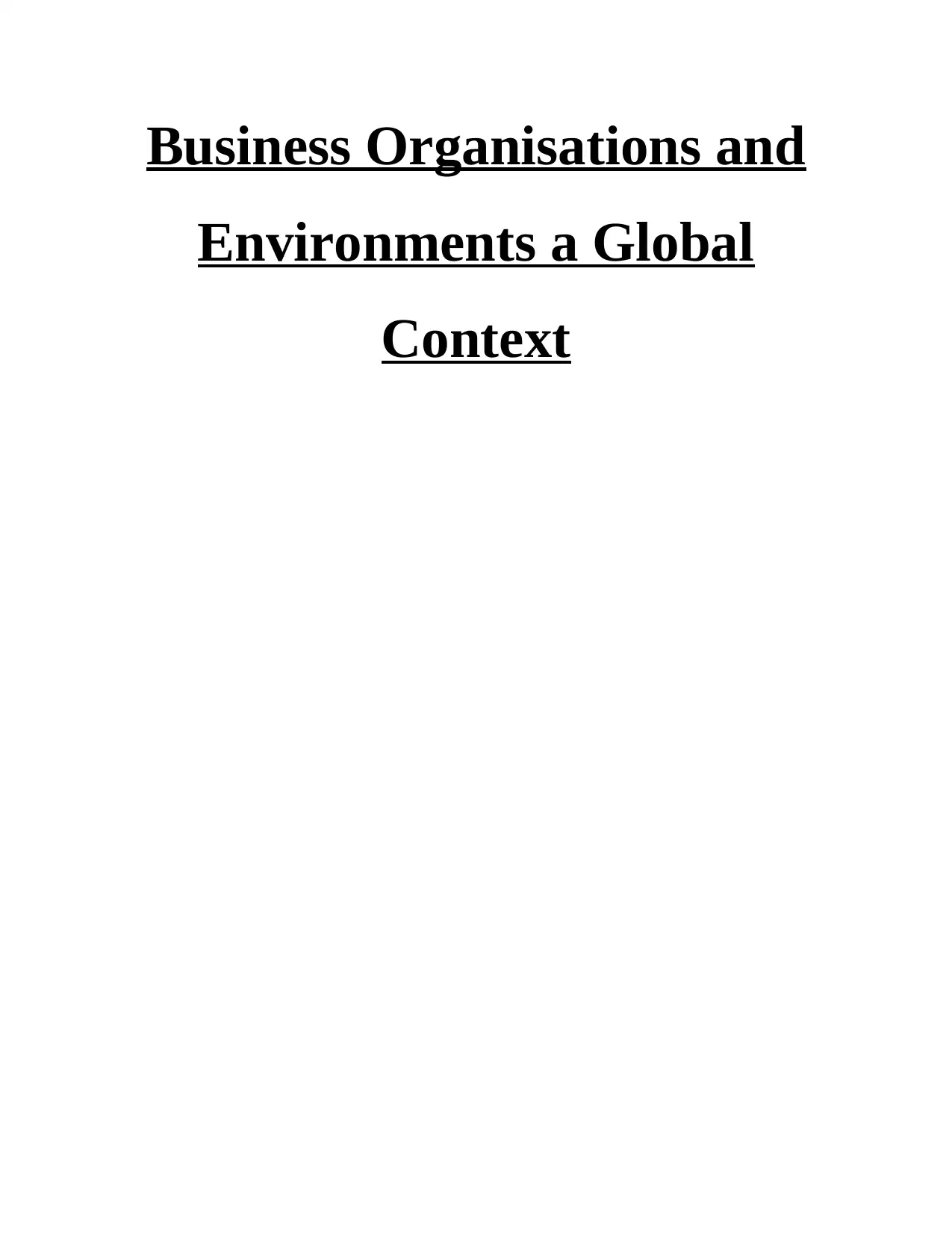
Business Organisations and
Environments a Global
Context
Environments a Global
Context
Paraphrase This Document
Need a fresh take? Get an instant paraphrase of this document with our AI Paraphraser
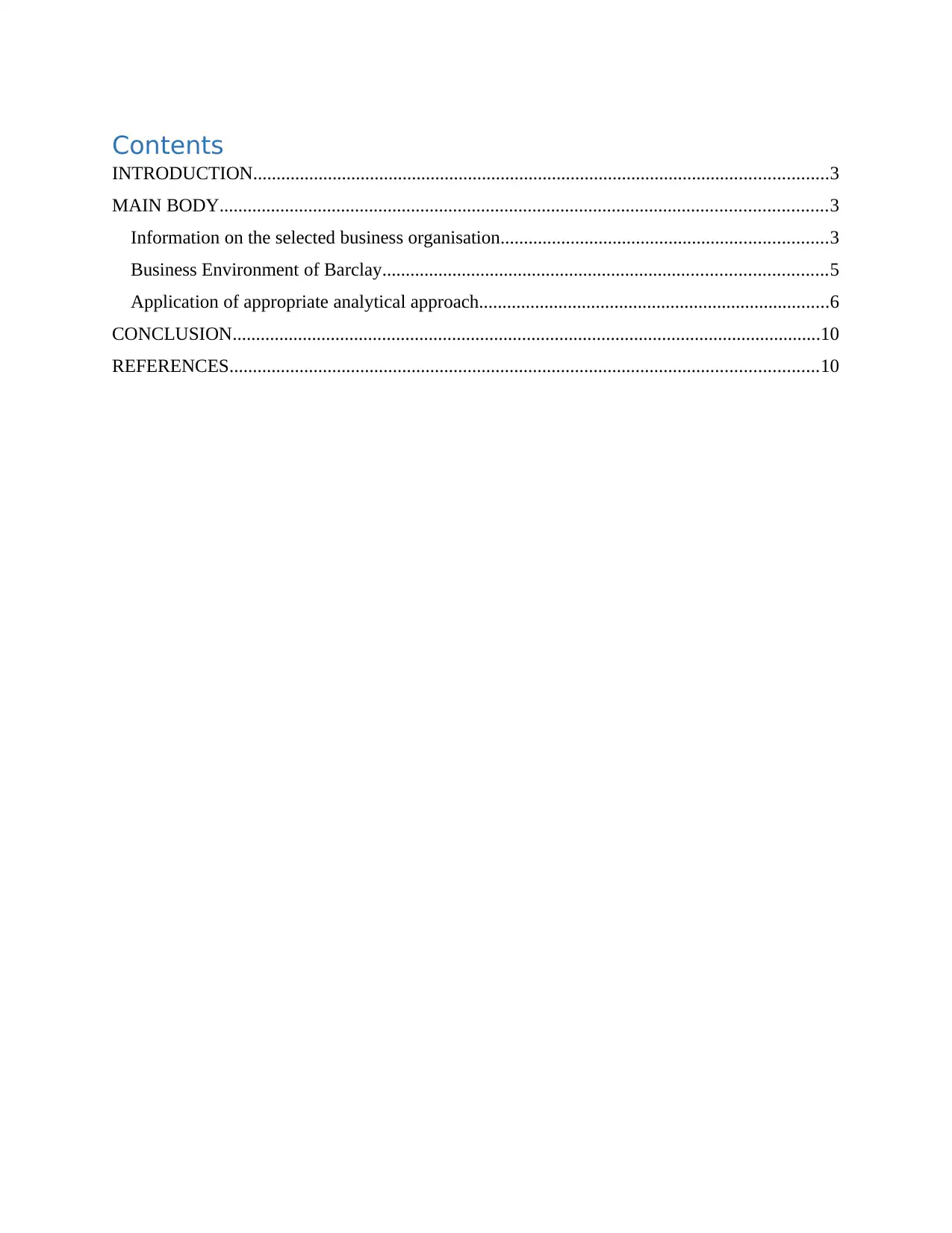
Contents
INTRODUCTION...........................................................................................................................3
MAIN BODY..................................................................................................................................3
Information on the selected business organisation......................................................................3
Business Environment of Barclay...............................................................................................5
Application of appropriate analytical approach...........................................................................6
CONCLUSION..............................................................................................................................10
REFERENCES..............................................................................................................................10
INTRODUCTION...........................................................................................................................3
MAIN BODY..................................................................................................................................3
Information on the selected business organisation......................................................................3
Business Environment of Barclay...............................................................................................5
Application of appropriate analytical approach...........................................................................6
CONCLUSION..............................................................................................................................10
REFERENCES..............................................................................................................................10
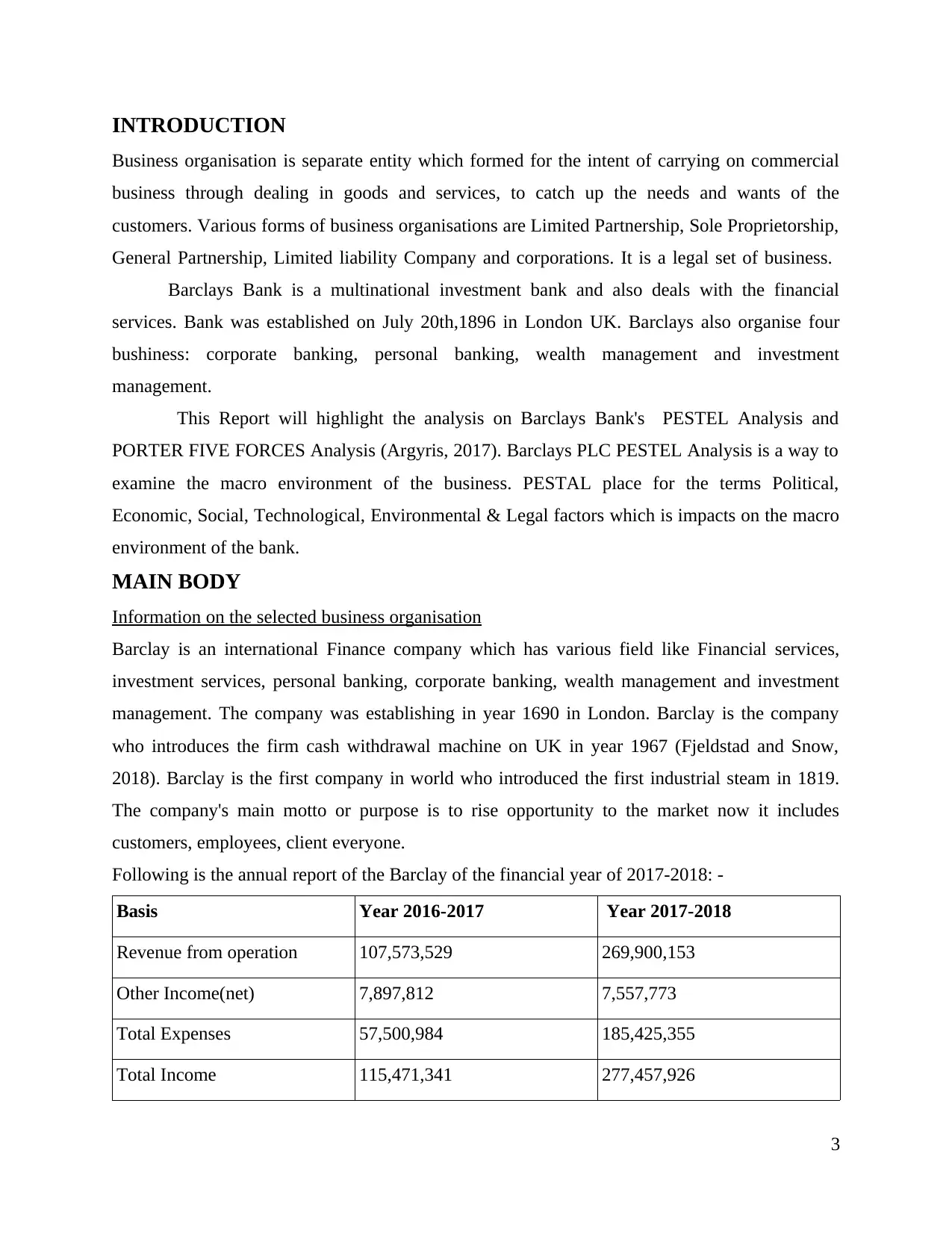
INTRODUCTION
Business organisation is separate entity which formed for the intent of carrying on commercial
business through dealing in goods and services, to catch up the needs and wants of the
customers. Various forms of business organisations are Limited Partnership, Sole Proprietorship,
General Partnership, Limited liability Company and corporations. It is a legal set of business.
Barclays Bank is a multinational investment bank and also deals with the financial
services. Bank was established on July 20th,1896 in London UK. Barclays also organise four
bushiness: corporate banking, personal banking, wealth management and investment
management.
This Report will highlight the analysis on Barclays Bank's PESTEL Analysis and
PORTER FIVE FORCES Analysis (Argyris, 2017). Barclays PLC PESTEL Analysis is a way to
examine the macro environment of the business. PESTAL place for the terms Political,
Economic, Social, Technological, Environmental & Legal factors which is impacts on the macro
environment of the bank.
MAIN BODY
Information on the selected business organisation
Barclay is an international Finance company which has various field like Financial services,
investment services, personal banking, corporate banking, wealth management and investment
management. The company was establishing in year 1690 in London. Barclay is the company
who introduces the firm cash withdrawal machine on UK in year 1967 (Fjeldstad and Snow,
2018). Barclay is the first company in world who introduced the first industrial steam in 1819.
The company's main motto or purpose is to rise opportunity to the market now it includes
customers, employees, client everyone.
Following is the annual report of the Barclay of the financial year of 2017-2018: -
Basis Year 2016-2017 Year 2017-2018
Revenue from operation 107,573,529 269,900,153
Other Income(net) 7,897,812 7,557,773
Total Expenses 57,500,984 185,425,355
Total Income 115,471,341 277,457,926
3
Business organisation is separate entity which formed for the intent of carrying on commercial
business through dealing in goods and services, to catch up the needs and wants of the
customers. Various forms of business organisations are Limited Partnership, Sole Proprietorship,
General Partnership, Limited liability Company and corporations. It is a legal set of business.
Barclays Bank is a multinational investment bank and also deals with the financial
services. Bank was established on July 20th,1896 in London UK. Barclays also organise four
bushiness: corporate banking, personal banking, wealth management and investment
management.
This Report will highlight the analysis on Barclays Bank's PESTEL Analysis and
PORTER FIVE FORCES Analysis (Argyris, 2017). Barclays PLC PESTEL Analysis is a way to
examine the macro environment of the business. PESTAL place for the terms Political,
Economic, Social, Technological, Environmental & Legal factors which is impacts on the macro
environment of the bank.
MAIN BODY
Information on the selected business organisation
Barclay is an international Finance company which has various field like Financial services,
investment services, personal banking, corporate banking, wealth management and investment
management. The company was establishing in year 1690 in London. Barclay is the company
who introduces the firm cash withdrawal machine on UK in year 1967 (Fjeldstad and Snow,
2018). Barclay is the first company in world who introduced the first industrial steam in 1819.
The company's main motto or purpose is to rise opportunity to the market now it includes
customers, employees, client everyone.
Following is the annual report of the Barclay of the financial year of 2017-2018: -
Basis Year 2016-2017 Year 2017-2018
Revenue from operation 107,573,529 269,900,153
Other Income(net) 7,897,812 7,557,773
Total Expenses 57,500,984 185,425,355
Total Income 115,471,341 277,457,926
3
⊘ This is a preview!⊘
Do you want full access?
Subscribe today to unlock all pages.

Trusted by 1+ million students worldwide
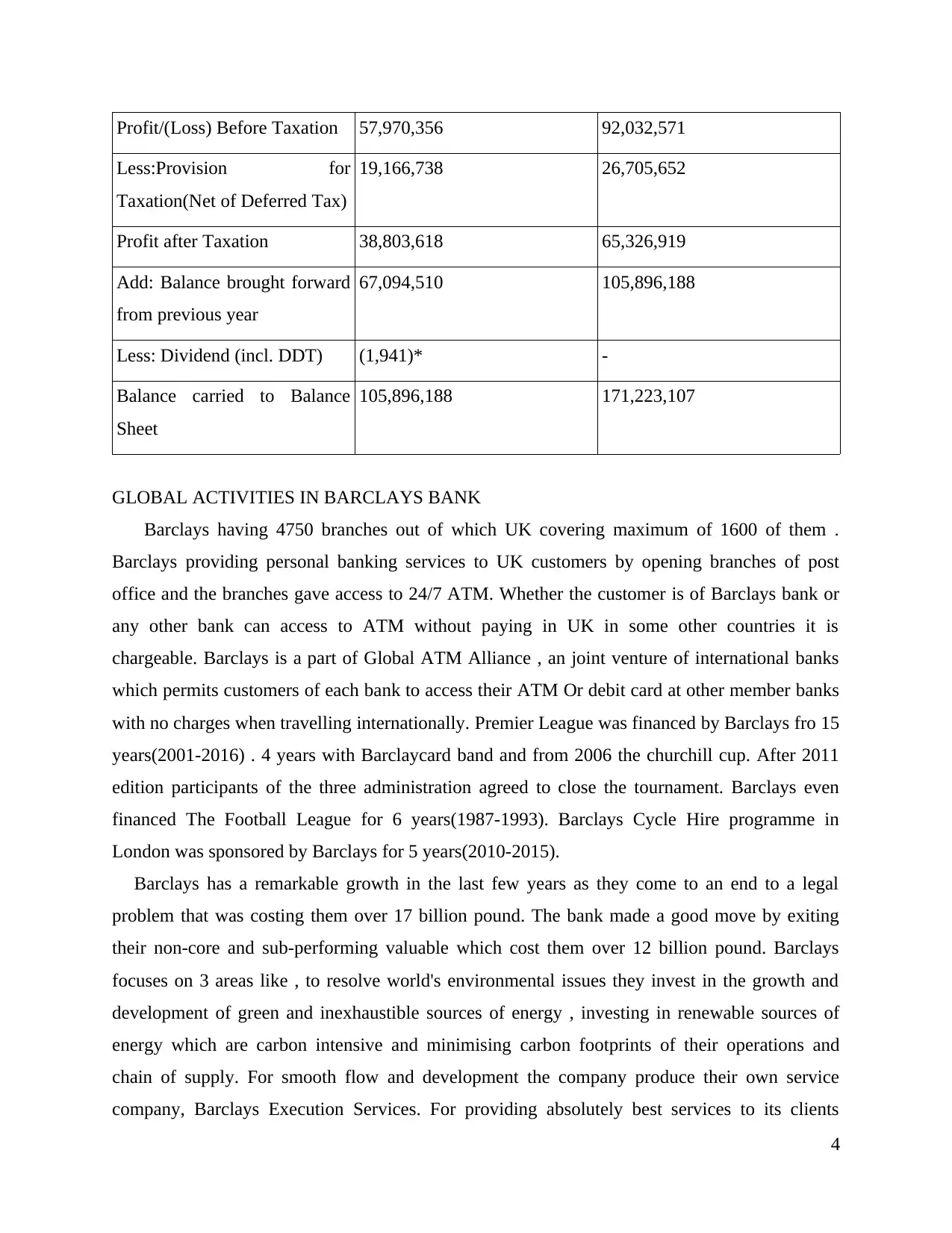
Profit/(Loss) Before Taxation 57,970,356 92,032,571
Less:Provision for
Taxation(Net of Deferred Tax)
19,166,738 26,705,652
Profit after Taxation 38,803,618 65,326,919
Add: Balance brought forward
from previous year
67,094,510 105,896,188
Less: Dividend (incl. DDT) (1,941)* -
Balance carried to Balance
Sheet
105,896,188 171,223,107
GLOBAL ACTIVITIES IN BARCLAYS BANK
Barclays having 4750 branches out of which UK covering maximum of 1600 of them .
Barclays providing personal banking services to UK customers by opening branches of post
office and the branches gave access to 24/7 ATM. Whether the customer is of Barclays bank or
any other bank can access to ATM without paying in UK in some other countries it is
chargeable. Barclays is a part of Global ATM Alliance , an joint venture of international banks
which permits customers of each bank to access their ATM Or debit card at other member banks
with no charges when travelling internationally. Premier League was financed by Barclays fro 15
years(2001-2016) . 4 years with Barclaycard band and from 2006 the churchill cup. After 2011
edition participants of the three administration agreed to close the tournament. Barclays even
financed The Football League for 6 years(1987-1993). Barclays Cycle Hire programme in
London was sponsored by Barclays for 5 years(2010-2015).
Barclays has a remarkable growth in the last few years as they come to an end to a legal
problem that was costing them over 17 billion pound. The bank made a good move by exiting
their non-core and sub-performing valuable which cost them over 12 billion pound. Barclays
focuses on 3 areas like , to resolve world's environmental issues they invest in the growth and
development of green and inexhaustible sources of energy , investing in renewable sources of
energy which are carbon intensive and minimising carbon footprints of their operations and
chain of supply. For smooth flow and development the company produce their own service
company, Barclays Execution Services. For providing absolutely best services to its clients
4
Less:Provision for
Taxation(Net of Deferred Tax)
19,166,738 26,705,652
Profit after Taxation 38,803,618 65,326,919
Add: Balance brought forward
from previous year
67,094,510 105,896,188
Less: Dividend (incl. DDT) (1,941)* -
Balance carried to Balance
Sheet
105,896,188 171,223,107
GLOBAL ACTIVITIES IN BARCLAYS BANK
Barclays having 4750 branches out of which UK covering maximum of 1600 of them .
Barclays providing personal banking services to UK customers by opening branches of post
office and the branches gave access to 24/7 ATM. Whether the customer is of Barclays bank or
any other bank can access to ATM without paying in UK in some other countries it is
chargeable. Barclays is a part of Global ATM Alliance , an joint venture of international banks
which permits customers of each bank to access their ATM Or debit card at other member banks
with no charges when travelling internationally. Premier League was financed by Barclays fro 15
years(2001-2016) . 4 years with Barclaycard band and from 2006 the churchill cup. After 2011
edition participants of the three administration agreed to close the tournament. Barclays even
financed The Football League for 6 years(1987-1993). Barclays Cycle Hire programme in
London was sponsored by Barclays for 5 years(2010-2015).
Barclays has a remarkable growth in the last few years as they come to an end to a legal
problem that was costing them over 17 billion pound. The bank made a good move by exiting
their non-core and sub-performing valuable which cost them over 12 billion pound. Barclays
focuses on 3 areas like , to resolve world's environmental issues they invest in the growth and
development of green and inexhaustible sources of energy , investing in renewable sources of
energy which are carbon intensive and minimising carbon footprints of their operations and
chain of supply. For smooth flow and development the company produce their own service
company, Barclays Execution Services. For providing absolutely best services to its clients
4
Paraphrase This Document
Need a fresh take? Get an instant paraphrase of this document with our AI Paraphraser
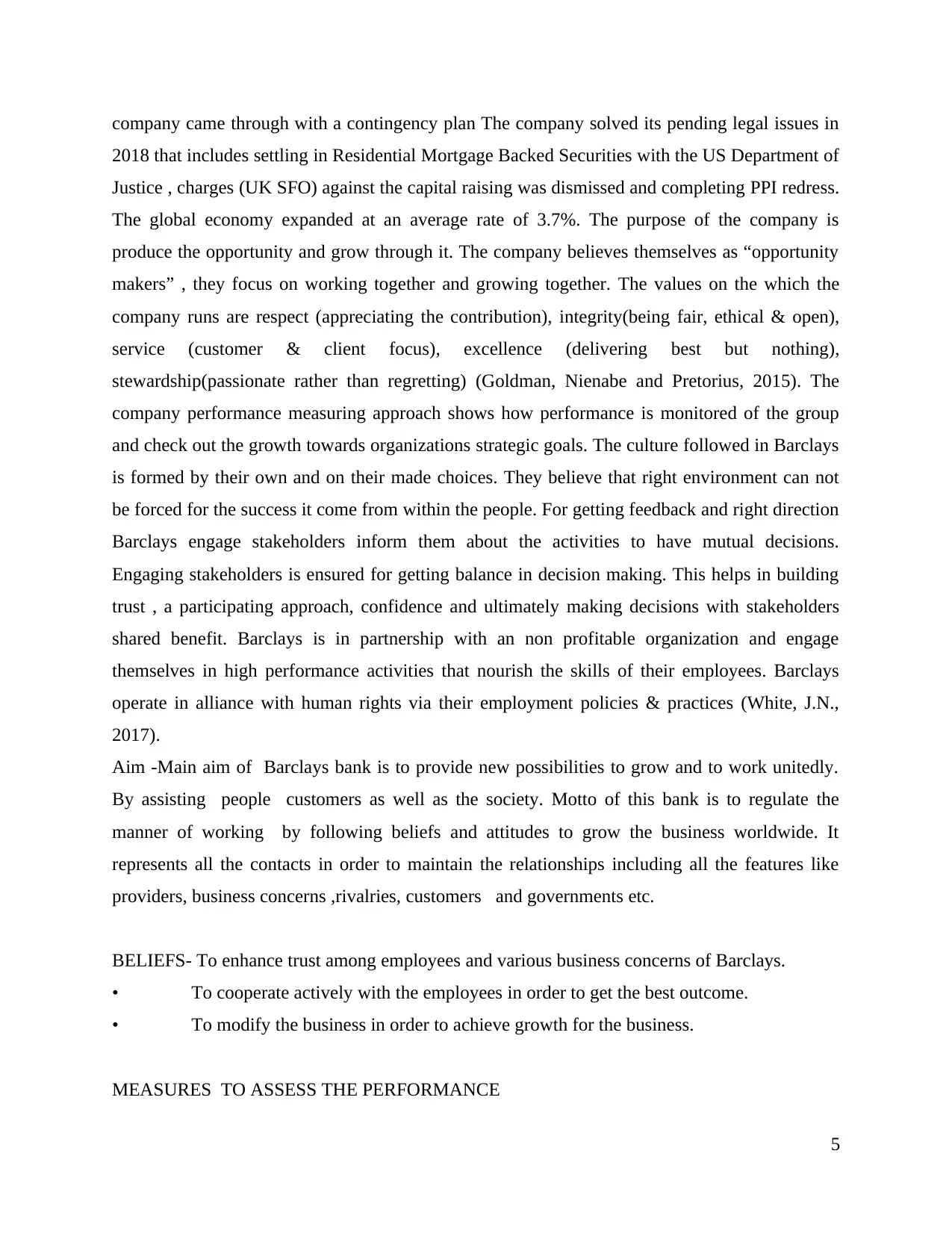
company came through with a contingency plan The company solved its pending legal issues in
2018 that includes settling in Residential Mortgage Backed Securities with the US Department of
Justice , charges (UK SFO) against the capital raising was dismissed and completing PPI redress.
The global economy expanded at an average rate of 3.7%. The purpose of the company is
produce the opportunity and grow through it. The company believes themselves as “opportunity
makers” , they focus on working together and growing together. The values on the which the
company runs are respect (appreciating the contribution), integrity(being fair, ethical & open),
service (customer & client focus), excellence (delivering best but nothing),
stewardship(passionate rather than regretting) (Goldman, Nienabe and Pretorius, 2015). The
company performance measuring approach shows how performance is monitored of the group
and check out the growth towards organizations strategic goals. The culture followed in Barclays
is formed by their own and on their made choices. They believe that right environment can not
be forced for the success it come from within the people. For getting feedback and right direction
Barclays engage stakeholders inform them about the activities to have mutual decisions.
Engaging stakeholders is ensured for getting balance in decision making. This helps in building
trust , a participating approach, confidence and ultimately making decisions with stakeholders
shared benefit. Barclays is in partnership with an non profitable organization and engage
themselves in high performance activities that nourish the skills of their employees. Barclays
operate in alliance with human rights via their employment policies & practices (White, J.N.,
2017).
Aim -Main aim of Barclays bank is to provide new possibilities to grow and to work unitedly.
By assisting people customers as well as the society. Motto of this bank is to regulate the
manner of working by following beliefs and attitudes to grow the business worldwide. It
represents all the contacts in order to maintain the relationships including all the features like
providers, business concerns ,rivalries, customers and governments etc.
BELIEFS- To enhance trust among employees and various business concerns of Barclays.
• To cooperate actively with the employees in order to get the best outcome.
• To modify the business in order to achieve growth for the business.
MEASURES TO ASSESS THE PERFORMANCE
5
2018 that includes settling in Residential Mortgage Backed Securities with the US Department of
Justice , charges (UK SFO) against the capital raising was dismissed and completing PPI redress.
The global economy expanded at an average rate of 3.7%. The purpose of the company is
produce the opportunity and grow through it. The company believes themselves as “opportunity
makers” , they focus on working together and growing together. The values on the which the
company runs are respect (appreciating the contribution), integrity(being fair, ethical & open),
service (customer & client focus), excellence (delivering best but nothing),
stewardship(passionate rather than regretting) (Goldman, Nienabe and Pretorius, 2015). The
company performance measuring approach shows how performance is monitored of the group
and check out the growth towards organizations strategic goals. The culture followed in Barclays
is formed by their own and on their made choices. They believe that right environment can not
be forced for the success it come from within the people. For getting feedback and right direction
Barclays engage stakeholders inform them about the activities to have mutual decisions.
Engaging stakeholders is ensured for getting balance in decision making. This helps in building
trust , a participating approach, confidence and ultimately making decisions with stakeholders
shared benefit. Barclays is in partnership with an non profitable organization and engage
themselves in high performance activities that nourish the skills of their employees. Barclays
operate in alliance with human rights via their employment policies & practices (White, J.N.,
2017).
Aim -Main aim of Barclays bank is to provide new possibilities to grow and to work unitedly.
By assisting people customers as well as the society. Motto of this bank is to regulate the
manner of working by following beliefs and attitudes to grow the business worldwide. It
represents all the contacts in order to maintain the relationships including all the features like
providers, business concerns ,rivalries, customers and governments etc.
BELIEFS- To enhance trust among employees and various business concerns of Barclays.
• To cooperate actively with the employees in order to get the best outcome.
• To modify the business in order to achieve growth for the business.
MEASURES TO ASSESS THE PERFORMANCE
5
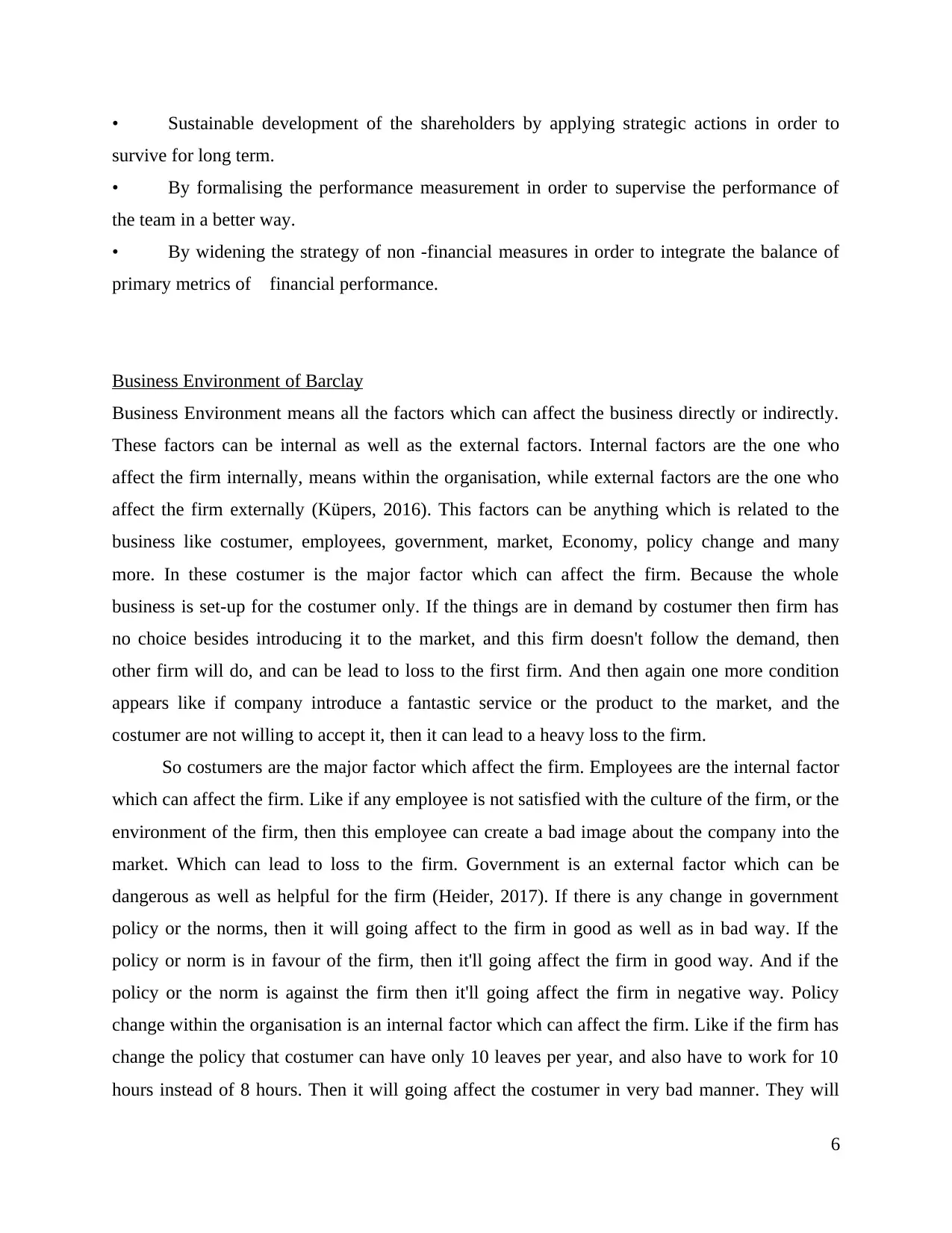
• Sustainable development of the shareholders by applying strategic actions in order to
survive for long term.
• By formalising the performance measurement in order to supervise the performance of
the team in a better way.
• By widening the strategy of non -financial measures in order to integrate the balance of
primary metrics of financial performance.
Business Environment of Barclay
Business Environment means all the factors which can affect the business directly or indirectly.
These factors can be internal as well as the external factors. Internal factors are the one who
affect the firm internally, means within the organisation, while external factors are the one who
affect the firm externally (Küpers, 2016). This factors can be anything which is related to the
business like costumer, employees, government, market, Economy, policy change and many
more. In these costumer is the major factor which can affect the firm. Because the whole
business is set-up for the costumer only. If the things are in demand by costumer then firm has
no choice besides introducing it to the market, and this firm doesn't follow the demand, then
other firm will do, and can be lead to loss to the first firm. And then again one more condition
appears like if company introduce a fantastic service or the product to the market, and the
costumer are not willing to accept it, then it can lead to a heavy loss to the firm.
So costumers are the major factor which affect the firm. Employees are the internal factor
which can affect the firm. Like if any employee is not satisfied with the culture of the firm, or the
environment of the firm, then this employee can create a bad image about the company into the
market. Which can lead to loss to the firm. Government is an external factor which can be
dangerous as well as helpful for the firm (Heider, 2017). If there is any change in government
policy or the norms, then it will going affect to the firm in good as well as in bad way. If the
policy or norm is in favour of the firm, then it'll going affect the firm in good way. And if the
policy or the norm is against the firm then it'll going affect the firm in negative way. Policy
change within the organisation is an internal factor which can affect the firm. Like if the firm has
change the policy that costumer can have only 10 leaves per year, and also have to work for 10
hours instead of 8 hours. Then it will going affect the costumer in very bad manner. They will
6
survive for long term.
• By formalising the performance measurement in order to supervise the performance of
the team in a better way.
• By widening the strategy of non -financial measures in order to integrate the balance of
primary metrics of financial performance.
Business Environment of Barclay
Business Environment means all the factors which can affect the business directly or indirectly.
These factors can be internal as well as the external factors. Internal factors are the one who
affect the firm internally, means within the organisation, while external factors are the one who
affect the firm externally (Küpers, 2016). This factors can be anything which is related to the
business like costumer, employees, government, market, Economy, policy change and many
more. In these costumer is the major factor which can affect the firm. Because the whole
business is set-up for the costumer only. If the things are in demand by costumer then firm has
no choice besides introducing it to the market, and this firm doesn't follow the demand, then
other firm will do, and can be lead to loss to the first firm. And then again one more condition
appears like if company introduce a fantastic service or the product to the market, and the
costumer are not willing to accept it, then it can lead to a heavy loss to the firm.
So costumers are the major factor which affect the firm. Employees are the internal factor
which can affect the firm. Like if any employee is not satisfied with the culture of the firm, or the
environment of the firm, then this employee can create a bad image about the company into the
market. Which can lead to loss to the firm. Government is an external factor which can be
dangerous as well as helpful for the firm (Heider, 2017). If there is any change in government
policy or the norms, then it will going affect to the firm in good as well as in bad way. If the
policy or norm is in favour of the firm, then it'll going affect the firm in good way. And if the
policy or the norm is against the firm then it'll going affect the firm in negative way. Policy
change within the organisation is an internal factor which can affect the firm. Like if the firm has
change the policy that costumer can have only 10 leaves per year, and also have to work for 10
hours instead of 8 hours. Then it will going affect the costumer in very bad manner. They will
6
⊘ This is a preview!⊘
Do you want full access?
Subscribe today to unlock all pages.

Trusted by 1+ million students worldwide
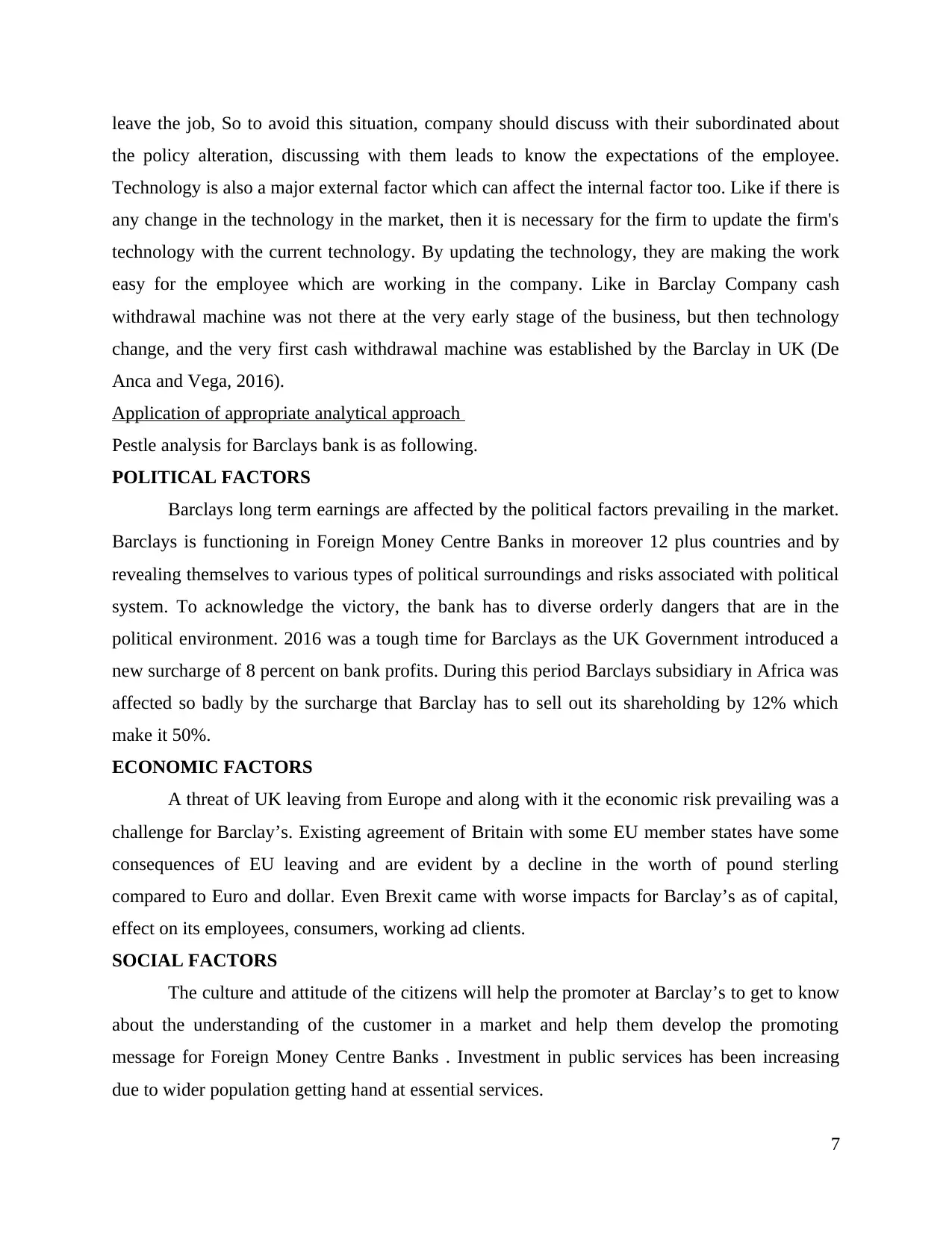
leave the job, So to avoid this situation, company should discuss with their subordinated about
the policy alteration, discussing with them leads to know the expectations of the employee.
Technology is also a major external factor which can affect the internal factor too. Like if there is
any change in the technology in the market, then it is necessary for the firm to update the firm's
technology with the current technology. By updating the technology, they are making the work
easy for the employee which are working in the company. Like in Barclay Company cash
withdrawal machine was not there at the very early stage of the business, but then technology
change, and the very first cash withdrawal machine was established by the Barclay in UK (De
Anca and Vega, 2016).
Application of appropriate analytical approach
Pestle analysis for Barclays bank is as following.
POLITICAL FACTORS
Barclays long term earnings are affected by the political factors prevailing in the market.
Barclays is functioning in Foreign Money Centre Banks in moreover 12 plus countries and by
revealing themselves to various types of political surroundings and risks associated with political
system. To acknowledge the victory, the bank has to diverse orderly dangers that are in the
political environment. 2016 was a tough time for Barclays as the UK Government introduced a
new surcharge of 8 percent on bank profits. During this period Barclays subsidiary in Africa was
affected so badly by the surcharge that Barclay has to sell out its shareholding by 12% which
make it 50%.
ECONOMIC FACTORS
A threat of UK leaving from Europe and along with it the economic risk prevailing was a
challenge for Barclay’s. Existing agreement of Britain with some EU member states have some
consequences of EU leaving and are evident by a decline in the worth of pound sterling
compared to Euro and dollar. Even Brexit came with worse impacts for Barclay’s as of capital,
effect on its employees, consumers, working ad clients.
SOCIAL FACTORS
The culture and attitude of the citizens will help the promoter at Barclay’s to get to know
about the understanding of the customer in a market and help them develop the promoting
message for Foreign Money Centre Banks . Investment in public services has been increasing
due to wider population getting hand at essential services.
7
the policy alteration, discussing with them leads to know the expectations of the employee.
Technology is also a major external factor which can affect the internal factor too. Like if there is
any change in the technology in the market, then it is necessary for the firm to update the firm's
technology with the current technology. By updating the technology, they are making the work
easy for the employee which are working in the company. Like in Barclay Company cash
withdrawal machine was not there at the very early stage of the business, but then technology
change, and the very first cash withdrawal machine was established by the Barclay in UK (De
Anca and Vega, 2016).
Application of appropriate analytical approach
Pestle analysis for Barclays bank is as following.
POLITICAL FACTORS
Barclays long term earnings are affected by the political factors prevailing in the market.
Barclays is functioning in Foreign Money Centre Banks in moreover 12 plus countries and by
revealing themselves to various types of political surroundings and risks associated with political
system. To acknowledge the victory, the bank has to diverse orderly dangers that are in the
political environment. 2016 was a tough time for Barclays as the UK Government introduced a
new surcharge of 8 percent on bank profits. During this period Barclays subsidiary in Africa was
affected so badly by the surcharge that Barclay has to sell out its shareholding by 12% which
make it 50%.
ECONOMIC FACTORS
A threat of UK leaving from Europe and along with it the economic risk prevailing was a
challenge for Barclay’s. Existing agreement of Britain with some EU member states have some
consequences of EU leaving and are evident by a decline in the worth of pound sterling
compared to Euro and dollar. Even Brexit came with worse impacts for Barclay’s as of capital,
effect on its employees, consumers, working ad clients.
SOCIAL FACTORS
The culture and attitude of the citizens will help the promoter at Barclay’s to get to know
about the understanding of the customer in a market and help them develop the promoting
message for Foreign Money Centre Banks . Investment in public services has been increasing
due to wider population getting hand at essential services.
7
Paraphrase This Document
Need a fresh take? Get an instant paraphrase of this document with our AI Paraphraser
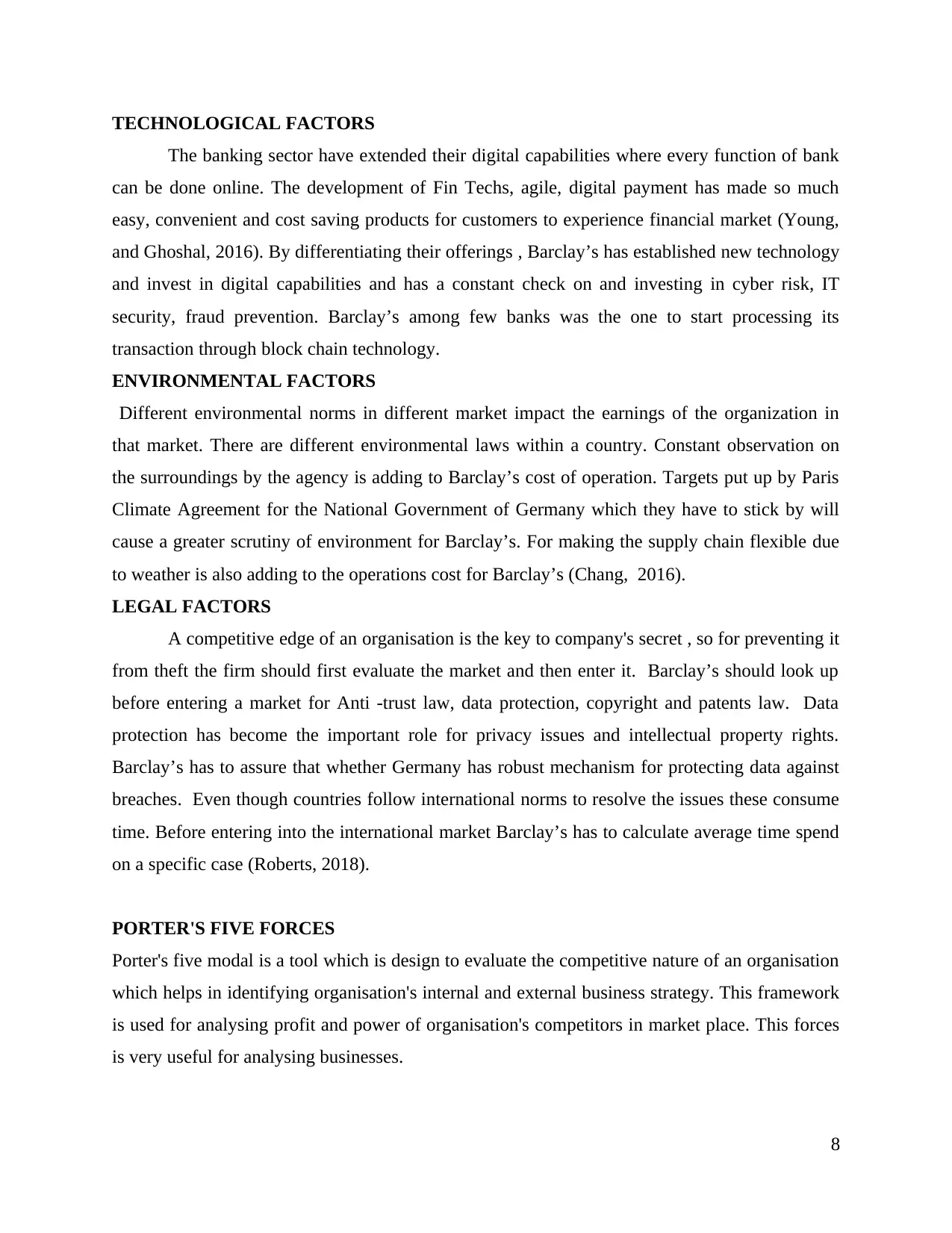
TECHNOLOGICAL FACTORS
The banking sector have extended their digital capabilities where every function of bank
can be done online. The development of Fin Techs, agile, digital payment has made so much
easy, convenient and cost saving products for customers to experience financial market (Young,
and Ghoshal, 2016). By differentiating their offerings , Barclay’s has established new technology
and invest in digital capabilities and has a constant check on and investing in cyber risk, IT
security, fraud prevention. Barclay’s among few banks was the one to start processing its
transaction through block chain technology.
ENVIRONMENTAL FACTORS
Different environmental norms in different market impact the earnings of the organization in
that market. There are different environmental laws within a country. Constant observation on
the surroundings by the agency is adding to Barclay’s cost of operation. Targets put up by Paris
Climate Agreement for the National Government of Germany which they have to stick by will
cause a greater scrutiny of environment for Barclay’s. For making the supply chain flexible due
to weather is also adding to the operations cost for Barclay’s (Chang, 2016).
LEGAL FACTORS
A competitive edge of an organisation is the key to company's secret , so for preventing it
from theft the firm should first evaluate the market and then enter it. Barclay’s should look up
before entering a market for Anti -trust law, data protection, copyright and patents law. Data
protection has become the important role for privacy issues and intellectual property rights.
Barclay’s has to assure that whether Germany has robust mechanism for protecting data against
breaches. Even though countries follow international norms to resolve the issues these consume
time. Before entering into the international market Barclay’s has to calculate average time spend
on a specific case (Roberts, 2018).
PORTER'S FIVE FORCES
Porter's five modal is a tool which is design to evaluate the competitive nature of an organisation
which helps in identifying organisation's internal and external business strategy. This framework
is used for analysing profit and power of organisation's competitors in market place. This forces
is very useful for analysing businesses.
8
The banking sector have extended their digital capabilities where every function of bank
can be done online. The development of Fin Techs, agile, digital payment has made so much
easy, convenient and cost saving products for customers to experience financial market (Young,
and Ghoshal, 2016). By differentiating their offerings , Barclay’s has established new technology
and invest in digital capabilities and has a constant check on and investing in cyber risk, IT
security, fraud prevention. Barclay’s among few banks was the one to start processing its
transaction through block chain technology.
ENVIRONMENTAL FACTORS
Different environmental norms in different market impact the earnings of the organization in
that market. There are different environmental laws within a country. Constant observation on
the surroundings by the agency is adding to Barclay’s cost of operation. Targets put up by Paris
Climate Agreement for the National Government of Germany which they have to stick by will
cause a greater scrutiny of environment for Barclay’s. For making the supply chain flexible due
to weather is also adding to the operations cost for Barclay’s (Chang, 2016).
LEGAL FACTORS
A competitive edge of an organisation is the key to company's secret , so for preventing it
from theft the firm should first evaluate the market and then enter it. Barclay’s should look up
before entering a market for Anti -trust law, data protection, copyright and patents law. Data
protection has become the important role for privacy issues and intellectual property rights.
Barclay’s has to assure that whether Germany has robust mechanism for protecting data against
breaches. Even though countries follow international norms to resolve the issues these consume
time. Before entering into the international market Barclay’s has to calculate average time spend
on a specific case (Roberts, 2018).
PORTER'S FIVE FORCES
Porter's five modal is a tool which is design to evaluate the competitive nature of an organisation
which helps in identifying organisation's internal and external business strategy. This framework
is used for analysing profit and power of organisation's competitors in market place. This forces
is very useful for analysing businesses.
8
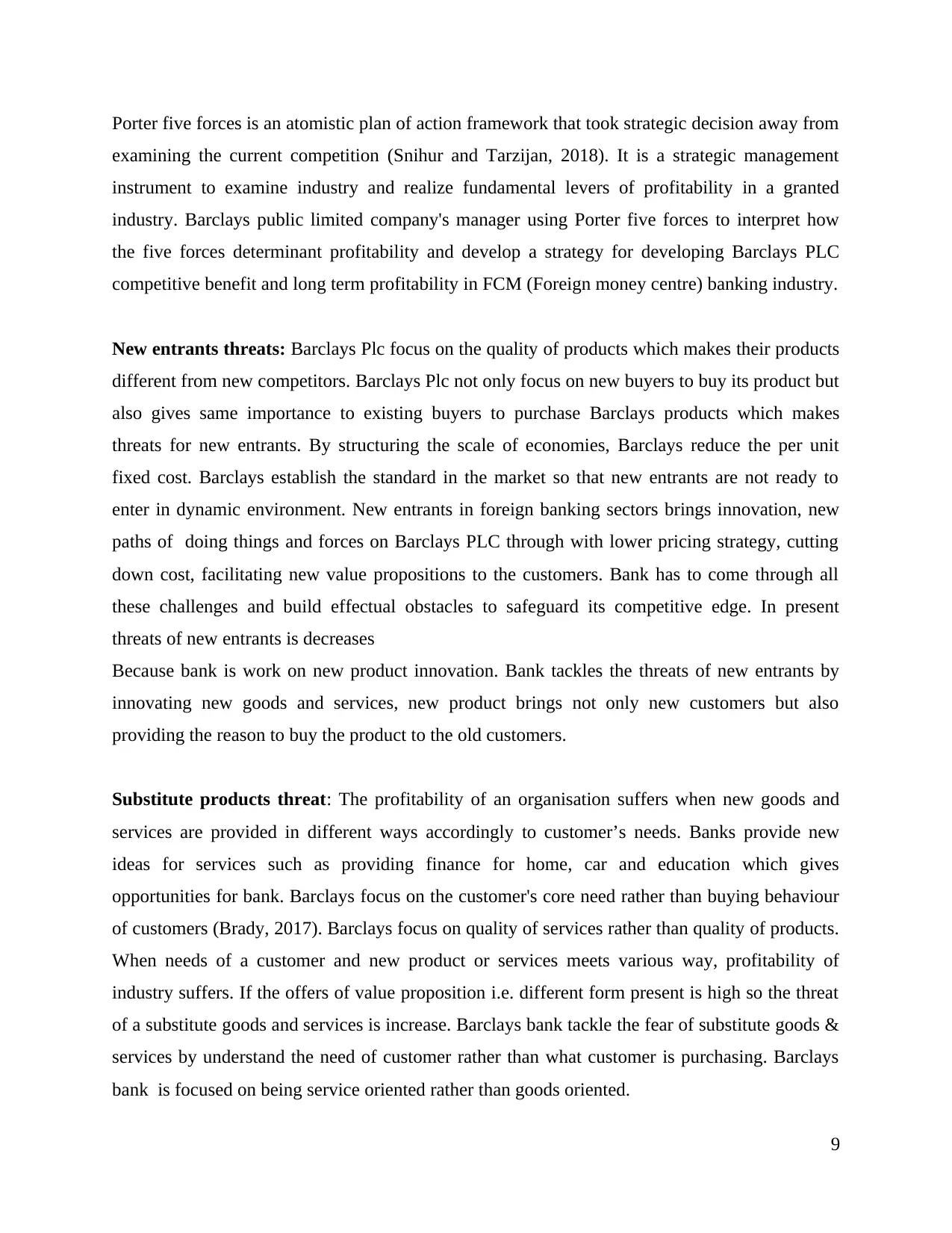
Porter five forces is an atomistic plan of action framework that took strategic decision away from
examining the current competition (Snihur and Tarzijan, 2018). It is a strategic management
instrument to examine industry and realize fundamental levers of profitability in a granted
industry. Barclays public limited company's manager using Porter five forces to interpret how
the five forces determinant profitability and develop a strategy for developing Barclays PLC
competitive benefit and long term profitability in FCM (Foreign money centre) banking industry.
New entrants threats: Barclays Plc focus on the quality of products which makes their products
different from new competitors. Barclays Plc not only focus on new buyers to buy its product but
also gives same importance to existing buyers to purchase Barclays products which makes
threats for new entrants. By structuring the scale of economies, Barclays reduce the per unit
fixed cost. Barclays establish the standard in the market so that new entrants are not ready to
enter in dynamic environment. New entrants in foreign banking sectors brings innovation, new
paths of doing things and forces on Barclays PLC through with lower pricing strategy, cutting
down cost, facilitating new value propositions to the customers. Bank has to come through all
these challenges and build effectual obstacles to safeguard its competitive edge. In present
threats of new entrants is decreases
Because bank is work on new product innovation. Bank tackles the threats of new entrants by
innovating new goods and services, new product brings not only new customers but also
providing the reason to buy the product to the old customers.
Substitute products threat: The profitability of an organisation suffers when new goods and
services are provided in different ways accordingly to customer’s needs. Banks provide new
ideas for services such as providing finance for home, car and education which gives
opportunities for bank. Barclays focus on the customer's core need rather than buying behaviour
of customers (Brady, 2017). Barclays focus on quality of services rather than quality of products.
When needs of a customer and new product or services meets various way, profitability of
industry suffers. If the offers of value proposition i.e. different form present is high so the threat
of a substitute goods and services is increase. Barclays bank tackle the fear of substitute goods &
services by understand the need of customer rather than what customer is purchasing. Barclays
bank is focused on being service oriented rather than goods oriented.
9
examining the current competition (Snihur and Tarzijan, 2018). It is a strategic management
instrument to examine industry and realize fundamental levers of profitability in a granted
industry. Barclays public limited company's manager using Porter five forces to interpret how
the five forces determinant profitability and develop a strategy for developing Barclays PLC
competitive benefit and long term profitability in FCM (Foreign money centre) banking industry.
New entrants threats: Barclays Plc focus on the quality of products which makes their products
different from new competitors. Barclays Plc not only focus on new buyers to buy its product but
also gives same importance to existing buyers to purchase Barclays products which makes
threats for new entrants. By structuring the scale of economies, Barclays reduce the per unit
fixed cost. Barclays establish the standard in the market so that new entrants are not ready to
enter in dynamic environment. New entrants in foreign banking sectors brings innovation, new
paths of doing things and forces on Barclays PLC through with lower pricing strategy, cutting
down cost, facilitating new value propositions to the customers. Bank has to come through all
these challenges and build effectual obstacles to safeguard its competitive edge. In present
threats of new entrants is decreases
Because bank is work on new product innovation. Bank tackles the threats of new entrants by
innovating new goods and services, new product brings not only new customers but also
providing the reason to buy the product to the old customers.
Substitute products threat: The profitability of an organisation suffers when new goods and
services are provided in different ways accordingly to customer’s needs. Banks provide new
ideas for services such as providing finance for home, car and education which gives
opportunities for bank. Barclays focus on the customer's core need rather than buying behaviour
of customers (Brady, 2017). Barclays focus on quality of services rather than quality of products.
When needs of a customer and new product or services meets various way, profitability of
industry suffers. If the offers of value proposition i.e. different form present is high so the threat
of a substitute goods and services is increase. Barclays bank tackle the fear of substitute goods &
services by understand the need of customer rather than what customer is purchasing. Barclays
bank is focused on being service oriented rather than goods oriented.
9
⊘ This is a preview!⊘
Do you want full access?
Subscribe today to unlock all pages.

Trusted by 1+ million students worldwide
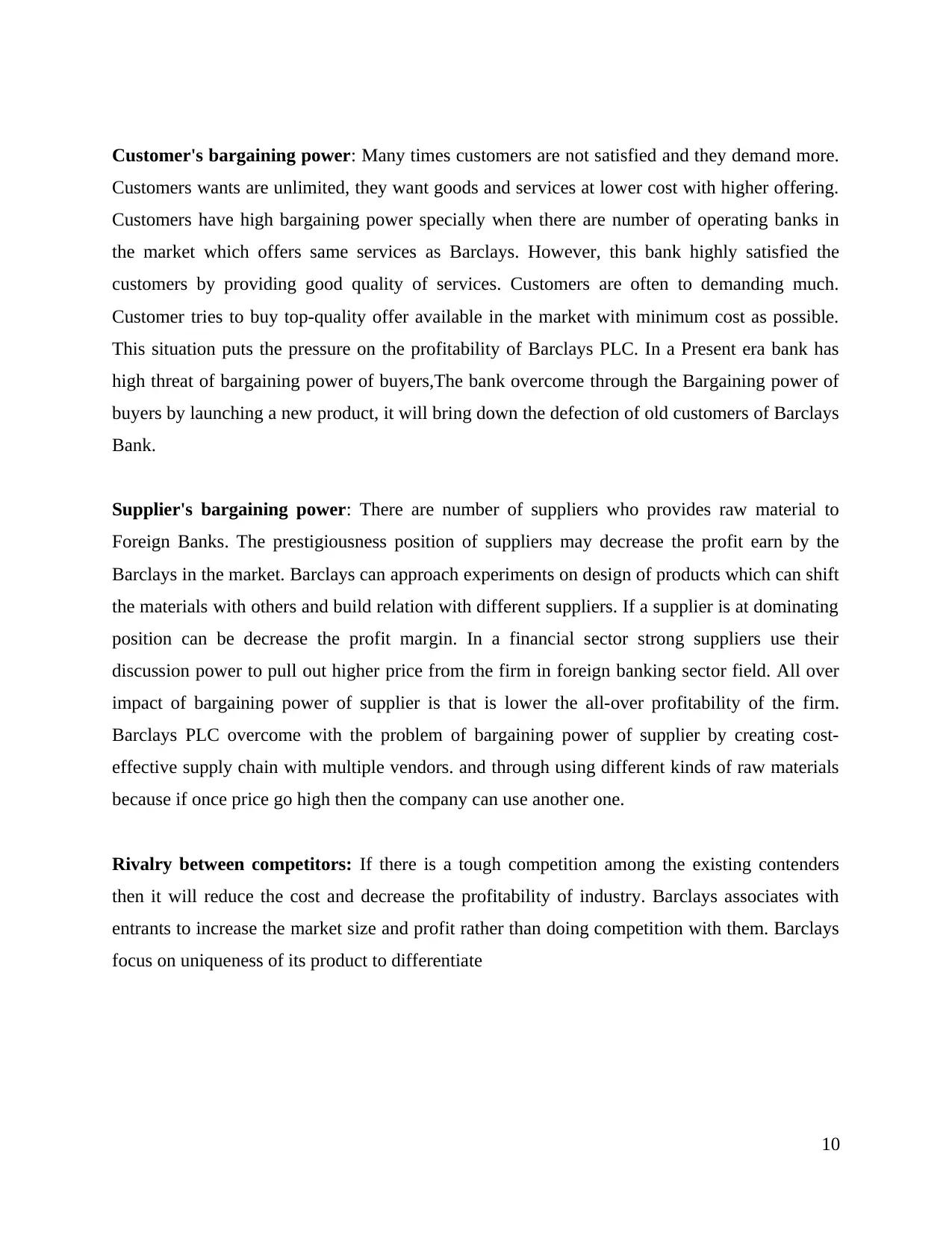
Customer's bargaining power: Many times customers are not satisfied and they demand more.
Customers wants are unlimited, they want goods and services at lower cost with higher offering.
Customers have high bargaining power specially when there are number of operating banks in
the market which offers same services as Barclays. However, this bank highly satisfied the
customers by providing good quality of services. Customers are often to demanding much.
Customer tries to buy top-quality offer available in the market with minimum cost as possible.
This situation puts the pressure on the profitability of Barclays PLC. In a Present era bank has
high threat of bargaining power of buyers,The bank overcome through the Bargaining power of
buyers by launching a new product, it will bring down the defection of old customers of Barclays
Bank.
Supplier's bargaining power: There are number of suppliers who provides raw material to
Foreign Banks. The prestigiousness position of suppliers may decrease the profit earn by the
Barclays in the market. Barclays can approach experiments on design of products which can shift
the materials with others and build relation with different suppliers. If a supplier is at dominating
position can be decrease the profit margin. In a financial sector strong suppliers use their
discussion power to pull out higher price from the firm in foreign banking sector field. All over
impact of bargaining power of supplier is that is lower the all-over profitability of the firm.
Barclays PLC overcome with the problem of bargaining power of supplier by creating cost-
effective supply chain with multiple vendors. and through using different kinds of raw materials
because if once price go high then the company can use another one.
Rivalry between competitors: If there is a tough competition among the existing contenders
then it will reduce the cost and decrease the profitability of industry. Barclays associates with
entrants to increase the market size and profit rather than doing competition with them. Barclays
focus on uniqueness of its product to differentiate
10
Customers wants are unlimited, they want goods and services at lower cost with higher offering.
Customers have high bargaining power specially when there are number of operating banks in
the market which offers same services as Barclays. However, this bank highly satisfied the
customers by providing good quality of services. Customers are often to demanding much.
Customer tries to buy top-quality offer available in the market with minimum cost as possible.
This situation puts the pressure on the profitability of Barclays PLC. In a Present era bank has
high threat of bargaining power of buyers,The bank overcome through the Bargaining power of
buyers by launching a new product, it will bring down the defection of old customers of Barclays
Bank.
Supplier's bargaining power: There are number of suppliers who provides raw material to
Foreign Banks. The prestigiousness position of suppliers may decrease the profit earn by the
Barclays in the market. Barclays can approach experiments on design of products which can shift
the materials with others and build relation with different suppliers. If a supplier is at dominating
position can be decrease the profit margin. In a financial sector strong suppliers use their
discussion power to pull out higher price from the firm in foreign banking sector field. All over
impact of bargaining power of supplier is that is lower the all-over profitability of the firm.
Barclays PLC overcome with the problem of bargaining power of supplier by creating cost-
effective supply chain with multiple vendors. and through using different kinds of raw materials
because if once price go high then the company can use another one.
Rivalry between competitors: If there is a tough competition among the existing contenders
then it will reduce the cost and decrease the profitability of industry. Barclays associates with
entrants to increase the market size and profit rather than doing competition with them. Barclays
focus on uniqueness of its product to differentiate
10
Paraphrase This Document
Need a fresh take? Get an instant paraphrase of this document with our AI Paraphraser
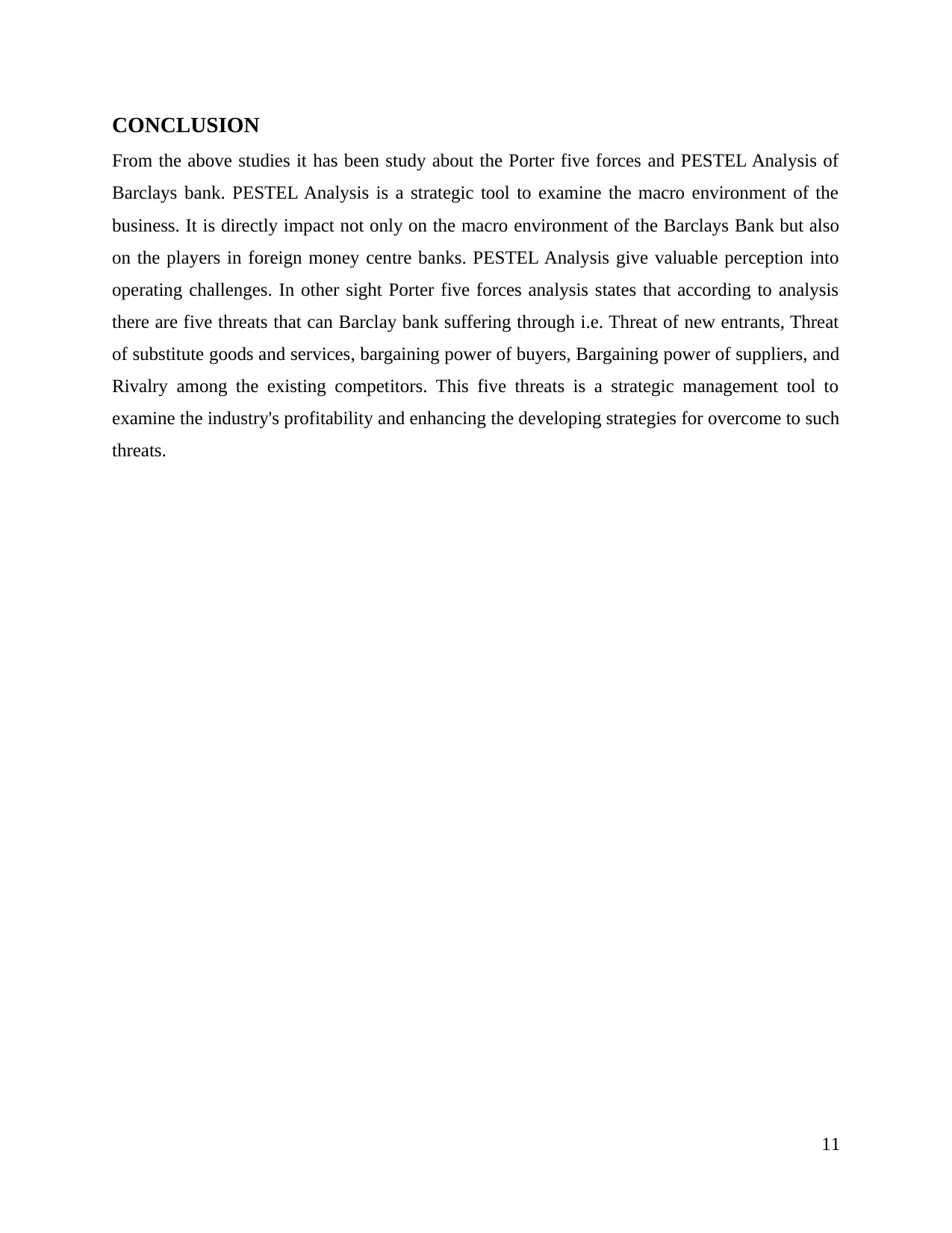
CONCLUSION
From the above studies it has been study about the Porter five forces and PESTEL Analysis of
Barclays bank. PESTEL Analysis is a strategic tool to examine the macro environment of the
business. It is directly impact not only on the macro environment of the Barclays Bank but also
on the players in foreign money centre banks. PESTEL Analysis give valuable perception into
operating challenges. In other sight Porter five forces analysis states that according to analysis
there are five threats that can Barclay bank suffering through i.e. Threat of new entrants, Threat
of substitute goods and services, bargaining power of buyers, Bargaining power of suppliers, and
Rivalry among the existing competitors. This five threats is a strategic management tool to
examine the industry's profitability and enhancing the developing strategies for overcome to such
threats.
11
From the above studies it has been study about the Porter five forces and PESTEL Analysis of
Barclays bank. PESTEL Analysis is a strategic tool to examine the macro environment of the
business. It is directly impact not only on the macro environment of the Barclays Bank but also
on the players in foreign money centre banks. PESTEL Analysis give valuable perception into
operating challenges. In other sight Porter five forces analysis states that according to analysis
there are five threats that can Barclay bank suffering through i.e. Threat of new entrants, Threat
of substitute goods and services, bargaining power of buyers, Bargaining power of suppliers, and
Rivalry among the existing competitors. This five threats is a strategic management tool to
examine the industry's profitability and enhancing the developing strategies for overcome to such
threats.
11

REFERENCES
Books and Journals
Argyris, C., 2017. Integrating the Individual and the Organization. Routledge.
Brady, R., 2017. Business as a System of Power. Routledge.
Chang, J.F., 2016. Business process management systems: strategy and implementation.
Auerbach Publications.
De Anca, C. and Vega, A.V., 2016. Managing diversity in the global organization: Creating new
Business values. Springer.
Fjeldstad, Ø.D. and Snow, C.C., 2018. Business models and organization design. Long Range
Planning. 51(1). pp.32-39.
Goldman, G.A., Nienaber, H. and Pretorius, M., 2015. THE ESSENCE OF THE
CONTEMPORARY BUSINESS ORGANIZATION: A CRITICAL REFLECTION.
Journal of Global Business & Technology, 11(2).
Heider, K.G., 2017. The economic organization. Routledge.
Küpers, W., 2016. A handbook of practical wisdom: Leadership, organization and integral
business practice. Routledge.
Roberts, J., 2018. Multinational business service firms: development of multinational
organization structures in the UK business service sector. Routledge.
Snihur, Y. and Tarzijan, J., 2018. Managing complexity in a multi-business-model
White, J.N., 2017. APPLICATION OF ORGANIZATIONAL THEORIES TO A
COMMUNITY MEDIA ORGANIZATION: AN EMPIRICAL STUDY OF A
BUSINESS ORGANIZATION. International Journal of Organizational Innovation
(Online).9(4). pp.54-63.
Young, C. and Ghoshal, S., 2016. Organization theory and the multinational corporation.
Springer.
12
Books and Journals
Argyris, C., 2017. Integrating the Individual and the Organization. Routledge.
Brady, R., 2017. Business as a System of Power. Routledge.
Chang, J.F., 2016. Business process management systems: strategy and implementation.
Auerbach Publications.
De Anca, C. and Vega, A.V., 2016. Managing diversity in the global organization: Creating new
Business values. Springer.
Fjeldstad, Ø.D. and Snow, C.C., 2018. Business models and organization design. Long Range
Planning. 51(1). pp.32-39.
Goldman, G.A., Nienaber, H. and Pretorius, M., 2015. THE ESSENCE OF THE
CONTEMPORARY BUSINESS ORGANIZATION: A CRITICAL REFLECTION.
Journal of Global Business & Technology, 11(2).
Heider, K.G., 2017. The economic organization. Routledge.
Küpers, W., 2016. A handbook of practical wisdom: Leadership, organization and integral
business practice. Routledge.
Roberts, J., 2018. Multinational business service firms: development of multinational
organization structures in the UK business service sector. Routledge.
Snihur, Y. and Tarzijan, J., 2018. Managing complexity in a multi-business-model
White, J.N., 2017. APPLICATION OF ORGANIZATIONAL THEORIES TO A
COMMUNITY MEDIA ORGANIZATION: AN EMPIRICAL STUDY OF A
BUSINESS ORGANIZATION. International Journal of Organizational Innovation
(Online).9(4). pp.54-63.
Young, C. and Ghoshal, S., 2016. Organization theory and the multinational corporation.
Springer.
12
⊘ This is a preview!⊘
Do you want full access?
Subscribe today to unlock all pages.

Trusted by 1+ million students worldwide
1 out of 15
Related Documents
Your All-in-One AI-Powered Toolkit for Academic Success.
+13062052269
info@desklib.com
Available 24*7 on WhatsApp / Email
![[object Object]](/_next/static/media/star-bottom.7253800d.svg)
Unlock your academic potential
Copyright © 2020–2025 A2Z Services. All Rights Reserved. Developed and managed by ZUCOL.




